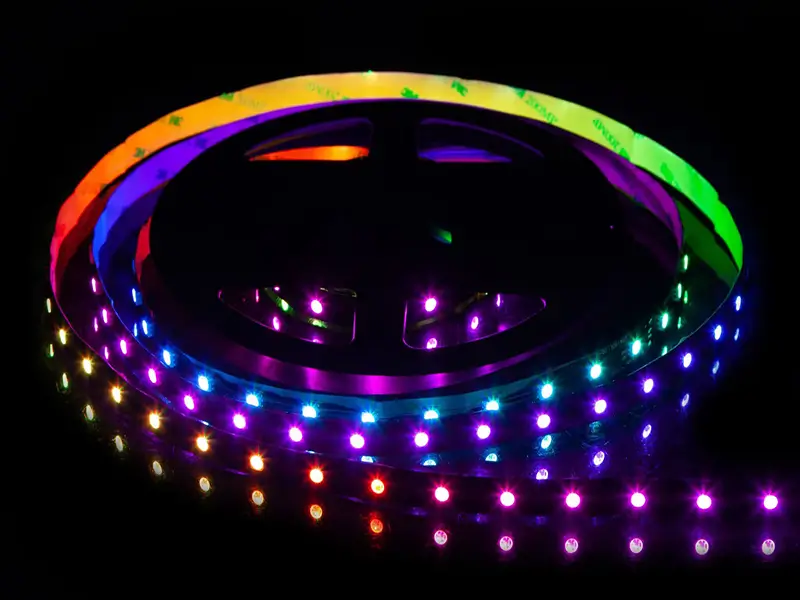
Are you looking for an addressable LED strip? Addressable LED strips provide stunning visuals and dynamic control. Because of energy saving, ease of installation, and low maintenance cost. Furniture, automobiles, advertising, lighting, ships, bars, and other industries widely use addressable LED strips.
Especially when you need a dynamic lighting solution, addressable LED strips are a great choice. Install them almost anywhere; they come in various colors – red, green, blue, RGB, etc. It’s hard to find another lighting solution that can compete with LED strips.
In this comprehensive guide, we’ll explore everything you need to know about addressable LED strips, from the basics of how addressable LED strips work to how to choose the right addressable LED strip for your project.
What is an Addressable LED Strip?
Addressable LED strips are digital LED strips that contain LEDs and driver chips. Similarly, it is also an LED strip with a control IC, which supports the control of each LEDs or LED group. This means that each LED itself can be autonomous and intelligent. There are two main types of addressable LED IC placement: ICs built into the LED structure and ICs placed outside the LED.
The Addressable LED strip allows you to apply different effects to different parts of the LED strip simultaneously or at intervals. It’s great for showcasing animations and other dynamic displays. As a result, you can produce stunning and even complex effects.
What is the Difference Between an Addressable LED Strip vs a Normal RGB LED Strip?
A series of LEDs wired together and controlled as a single unit forms a Normal RGB LED strip. This means that all the LEDs in the strip have the same color and brightness and will display the same pattern or effect.
Addressable LED strips have an IC controller embedded inside or outside. Control each LED individually within the unit. Set different colors and brightness for each LED, displaying unique patterns or effects. The IC controller communicates with the LEDs using control protocols such as DMX512 or SPI, enabling multiple possibilities for dynamic colors and animations.
Built-in IC vs. External IC vs. Normal RGB LED Strips
- Normal RGB LED strips do not have ICs. So, first, check if there is an IC. IC has two expressions: external IC and internal IC. If there’s an IC, then it’s addressable LED strips.
- Furthermore, you can check the connection line, if there is a signal data line, it is an addressable LED strip.
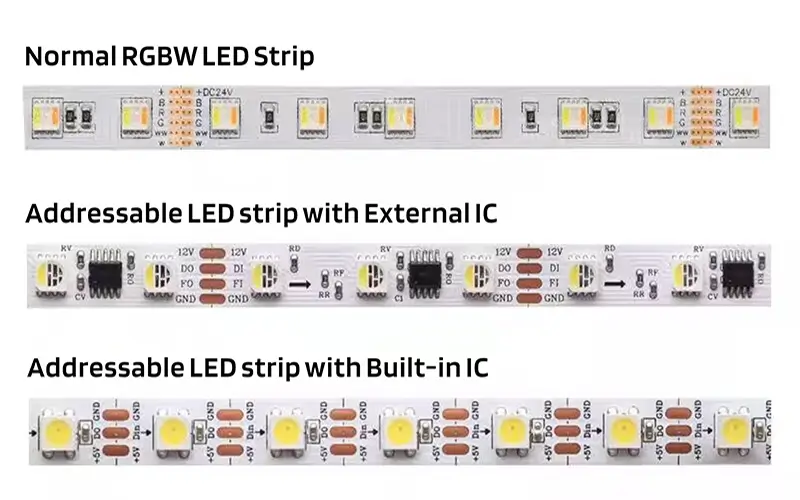
How Do Addressable LED Strips Work?
You need the following accessories to operate the addressable LED strip properly:
Addressable led strip
Power supply
Controller
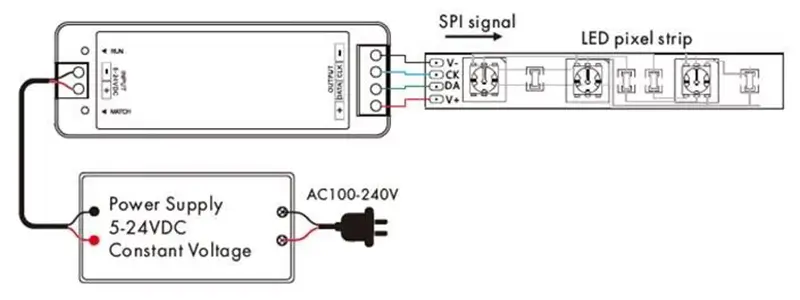
Each group of LEDs has an integrated circuit chip, which can control the color and brightness of this group of LEDs. One IC can control one or more LED lights, and you can send different control commands to each IC.
The controller of the addressable LED strip is also very special, which is different from the traditional RGB controller. They usually have a data lane and some even have a clock lane.
Finally, you’ll need to enter commands on the controller to control color and brightness changes for specific groups of LEDs. At the same time, the controller passes the appropriate signals to the IC chips on these LEDs, which execute commands to control the color and brightness changes of the LEDs.
Where are Addressable LED Strips Used For?
Addressable LED strips are popular for their dynamic control capabilities and stunning visuals. Some common uses for addressable LED strips include:
- Addressable LED strips find wide applications in KTVs, bars, gyms, etc., for interior decoration lighting.
- Illuminate high-rise buildings, bridges, etc., using addressable LED strips for architectural lighting.
- Signage and Advertising: Addressable LED strips are used to illuminate signage and advertising displays. They can be programmed to display scrolling text, animations, or color-changing effects.
- Create a festive and cozy atmosphere by decorating the home environment with addressable LED strips for home lighting.
- Stage Lighting: Addressable LED strips are popular in the entertainment industry, especially for stage lighting and concert visuals.
- Light Shows and Festivals: Addressable LED strips are an essential part of light shows and large festivals, creating stunning displays with synchronized light effects.

Addressable LED Strip Categories: DMX512 vs. SPI
Two main categories of addressable LED strips exist DMX512 and SPI addressable LED strips.
DMX512 Addressable LED Strip
DMX512 addressable LED strips utilize the DMX512 protocol and require a dedicated DMX controller or decoder to communicate with the DMX control system. Each LED is individually addressable, allowing unique DMX channel control. This enables complex and delicate lighting effects.
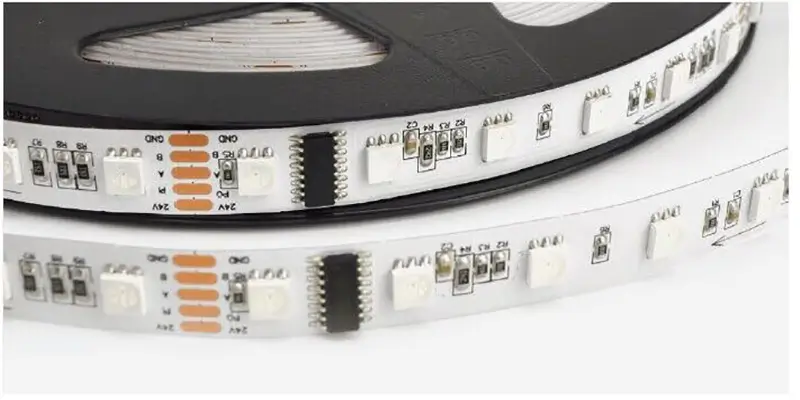
DMX512 is a lighting control protocol widely used in the entertainment and architectural lighting industries. It provides precise, synchronized lighting control across stages, events, and installations, including LED strips.
SPI Addressable LED Strip
SPI serves as a synchronous serial communication protocol commonly found in electronic devices, facilitating data transfer between devices. Controlling an SPI addressable LED strip requires a device such as a microcontroller (such as an Arduino or Raspberry Pi) or a dedicated LED controller that supports SPI communication.
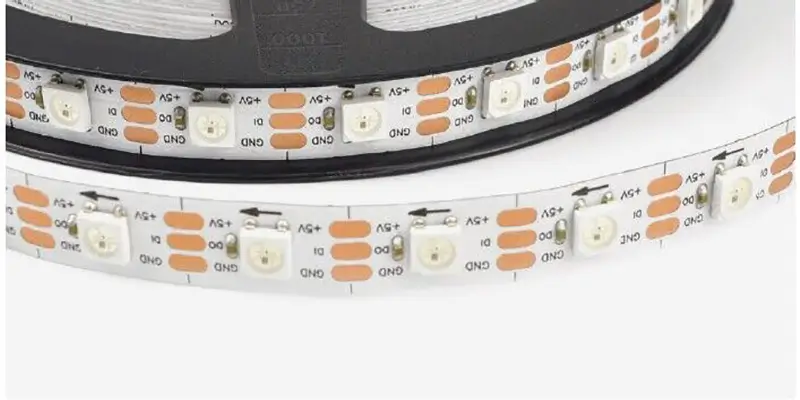
Lighting professionals often prefer SPI addressable LED strips due to their high-quality performance and seamless integration with other SPI-compatible devices in complex lighting setups.
Comparison Between DMX512 Vs. SPI Protocols
DMX512 and SPI are two different signal protocols in the field of digital lighting equipment control. Each type boasts distinct advantages and disadvantages, making them suitable for different applications and scenarios.
Signal Protocol
DMX512 is a general control protocol for digital lighting equipment and is currently a mature, synchronous parallel interface signal transmission technology. And SPI adopts serial, synchronous serial interface signal transmission technology, but the implementation of different IC manufacturers may be different.
Compatibility
DMX512 has a unified IC category and a standardized protocol with good compatibility. In contrast, due to the existence of multiple IC categories with slightly different protocols, the compatibility of SPI is relatively poor, resulting in a lack of luminaires that support SPI.
Wiring Complexity
DMX512 wiring tends to be more complicated than SPI, which offers a simpler wiring setup.
Reliability
DMX512 has advantages in reliability through breakpoint transmission and parallel signal transmission, ensuring high reliability. In contrast, SPI also uses breakpoint transmission but lacks the update transmission of two consecutive breakpoints, which makes its reliability slightly worse than DMX512.
Signal Anti-jamming
DMX512 has excellent anti-interference ability, especially for long-distance communication, providing strong anti-interference ability. On the contrary, SPI has poor anti-interference performance, especially when facing strong current magnetic interference during long-distance communication.
Cost Performance
DMX512 tends to be higher in terms of cost, while SPI offers a more affordable option.
Application Area
DMX512 finds widespread use in indoor and outdoor environments, synchronously controlling large advertising lighting and light shows. Conversely, SPI excels in smaller spaces, separate styling scenarios, and supporting facilities.
In summary, both DMX512 and SPI protocols have their own advantages and disadvantages that make them suitable for different lighting control applications. When you choose them, you need to carefully consider the specific requirements of the project, and then confirm which protocol is most suitable for your project.
How To Choose the Suitable Addressable LED Strip?
Choose the right addressable LED strip for your project. Here are a few important factors you can consider:
- Consider the size of the area you want to illuminate
- Decide on the color you want
- Choose the decoration style that suits you
- Make sure the light strip is dimmable or non-dimmable in case you want to change the mood or atmosphere
- Check the light strip you choose to make sure it is compatible with your electrical system
- Compare price and quality before buying
Voltage
Addressable light strips generally have 5V, 12V, and 24V. Conventionally, the voltage is related to the length of the light strip. Longer strips require higher voltages to maintain consistent brightness levels. Because it has the problem of voltage drop.
Why is there a voltage?
As the light strip gets longer, the longer the wire, the greater the resistance. The resistor causes a voltage drop, and the voltage drop causes the LED to dim. The LED at the beginning of the strip (closest to the power supply) will blink brightly. And the LEDs at the end of the strip will have a dimmed look.
- If mounting the strip behind the TV, a 5V addressable LED strip would be a good choice. It connects easily to a power source and is usually short in length. So the lower voltage doesn’t cause too much voltage drop.
- If you want to install LED light strips in your living room or bedroom, 24V addressable LED light strips may be the best choice. A higher voltage helps maintain a consistent brightness level over a longer period of time.
- If you want to make a small decorative piece, it doesn’t need to be installed too long. Then, a 12V addressable LED strip might fit. It provides a balance between the higher voltage required for longer strips and the lower voltage required for shorter strips.
LED Density
LED density refers to the number of LEDs per meter of strip. Ours are from 60 LEDs/meter to over 120 LEDs/meter. When choosing the LED density, the application and environment of the LED strip should be considered.
Type of Colors
When choosing the color of an addressable LED strip, the main consideration is the purpose of the lighting and the atmosphere of the environment. The most common color types include:
- Single-color addressable LED strips: such as white, red, green, blue, etc. Colors cannot be changed or programmed.
- Dual White Addressable LED Strips: These LED strips feature two different shades of white that can be mixed for different color temperatures, from warm white to cool white.
- RGB addressable LED strip: it mainly produces three colors red, green, and blue, and these colors can be combined to produce multiple colors. You can change the color with a compatible controller.
- RGBW addressable LED strip: This type of LED strip has an additional white LED. In addition to RGB colors, pure white can also be produced. It allows for more color options and greater lighting design flexibility.
IP Rate
If you need to install addressable LED strips outdoors, you can choose IP20 or IP65. However, for units submerged in water for short periods of time, IP67 or even IP68 would be safer.
- If you plan to use the LED strip light in a clean and dry indoor environment such as a living room or bedroom, the IP20 rating is enough.
- If you plan to install the LED strip in an area with a lot of dust or debris, it is recommended to choose IP65 or higher for a better dustproof effect.
- If you want to install the LED strip light outdoors, in an environment with high humidity or in contact with water. For example, in the swimming pool area, it is recommended to choose an IP-rated light strip to obtain a better waterproof effect.
IC type
IC type is an important factor to consider when choosing an addressable LED strip because it determines the characteristics and functionality of the strip. It is mainly a choice of built-in IC and external IC. Different ICs have different numbers of output channels, which affects the number of LEDs that can be controlled and the complexity of the patterns that can be created.
The IC also determines the communication protocol between the LED controller and the light strip. So, you need to choose according to your project. Selecting the correct IC type can ensure that the LED light strip meets your specific needs in terms of functionality and performance.
How to Choose the Right LED Controller for Addressable LED Strips?
When we choose an addressable LED strip and choose an LED controller, we need to consider the following factors:
- Compatibility: Make sure the LED controller is compatible with the specific IC type of the LED strip.
- Function: Consider the specific function you want your LED controller to perform. Is it compatible with a specific smart home system or app? Custom effects?
- Power supply: Consider the power supply compatibility of the LED strip and make sure the LED controller can handle the necessary voltage and current.
- Control method: How to control the LED strip. Do you want remote control, smartphone app or voice control compatibility?
By considering these factors, you can choose an LED controller that is compatible with your LED strip and meets your specific needs and preferences.
How to Wire Addressable LED Strip?
Before connecting DMX512 and SPI addressable light strips, you need to learn some basics of electronics. Addressable LED strips feature individually controllable LEDs, which means you can control the color and brightness of each LED independently.
DMX512 addressable LED strips:
You need to use the “address writer” provided by the IC manufacturer to set the dmx512 address into the DMX512 IC. You only need to set the dmx512 address once, and the DMX512 IC will save the data even if the power is off.
SPI addressable strips:
They do not need to set the address before use. SPI addressable light strips have different outlets according to different functions, and their wiring diagrams will also be different. Addressable light strips with resumable transfer functions will have a data channel and a backup data channel. Addressable light strips with a clock channel feature have a data channel and a clock channel.
DMX512 Addressable LED Strip Wiring Diagram
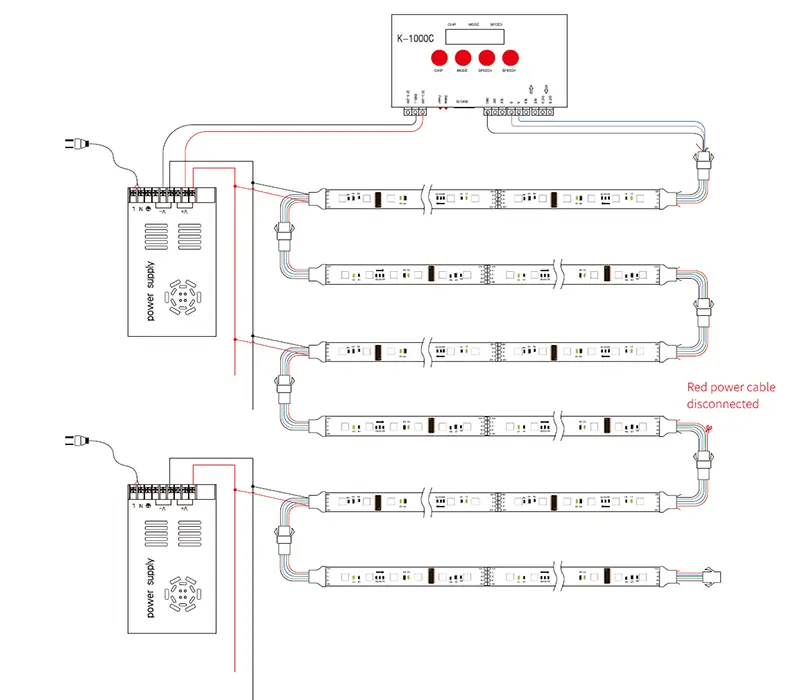
SPI Addressable LED Strip Wiring Diagram
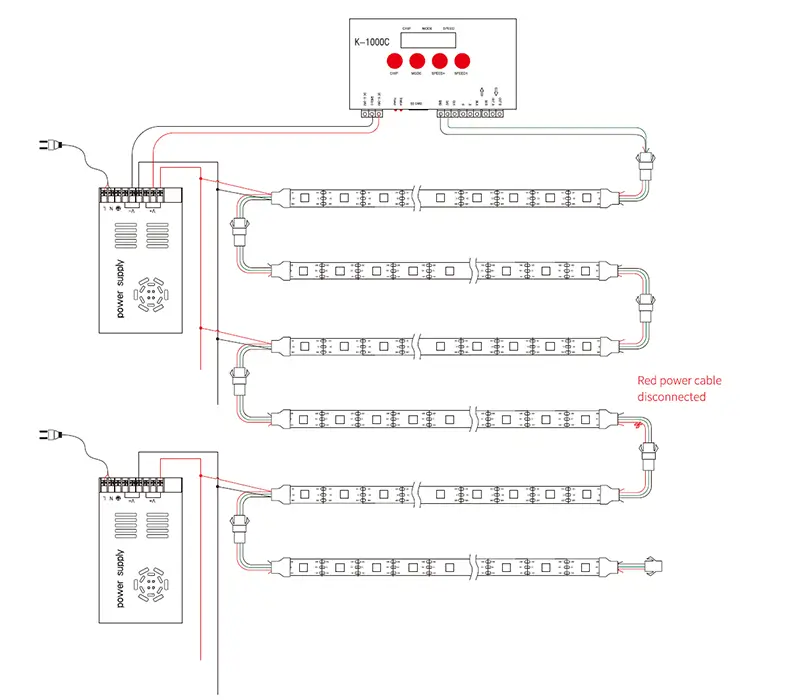
Breakpoint Transmission Wiring Diagram
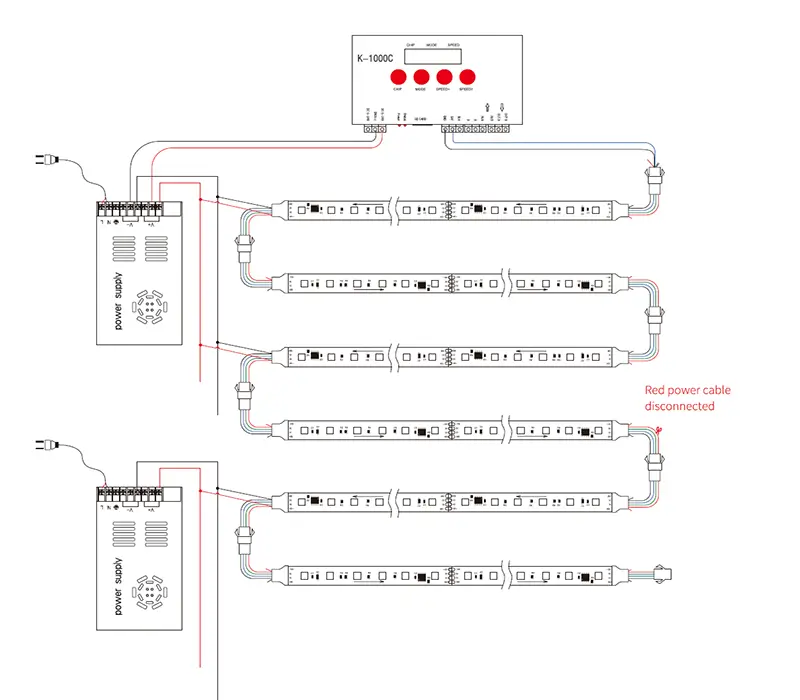
Conclusion
All in all, addressable LED strips are becoming more and more popular due to their versatility, and wide range of applications. It is important to consider factors such as IC type, data transfer speed, and LED controller and driver requirements.
Essenled is a manufacturer specializing in LED strip lights and LED neon flex. We support all lighting customization solutions and provide free sample testing. If you have any questions, please consult us.
FAQs
Addressable LED strips are LED strips with a control IC. It allows you to independently control the color and brightness of each LED, or a group of LEDs. is an advanced lighting solution, this level of control enables dynamic and customizable lighting effects.
Addressable LED strips work through an integrated microcontroller within each LED. Receive commands from DMX or SPI controllers. These signals instruct the LEDs to achieve the desired color and brightness, resulting in stunning lighting effects.
Yes, addressable LED strips can be cut at specific points. It’s the same as a normal light bar. Its cut point is usually between every LED or every few LEDs. However, cut the strip only at designated points to avoid damaging the circuit.
To program an addressable LED strip, you’ll need to write code with a compatible LED controller. This code will send data to the LED strip, controlling the color and brightness of individual LEDs or creating various lighting effects.
Yes, you can control the addressable LED strip from your phone via Bluetooth, Wi-Fi or other wireless communication methods. A variety of mobile apps and platforms allow you to interact with and control your addressable LED strips remotely.
Yes, it’s OK. You just need to parallel the data and power lines of multiple addressable LED strips to the microcontroller to use them together. But the premise is to ensure that there is a large enough power supply to power all the light strips. To avoid voltage drops and inconsistent lighting.
